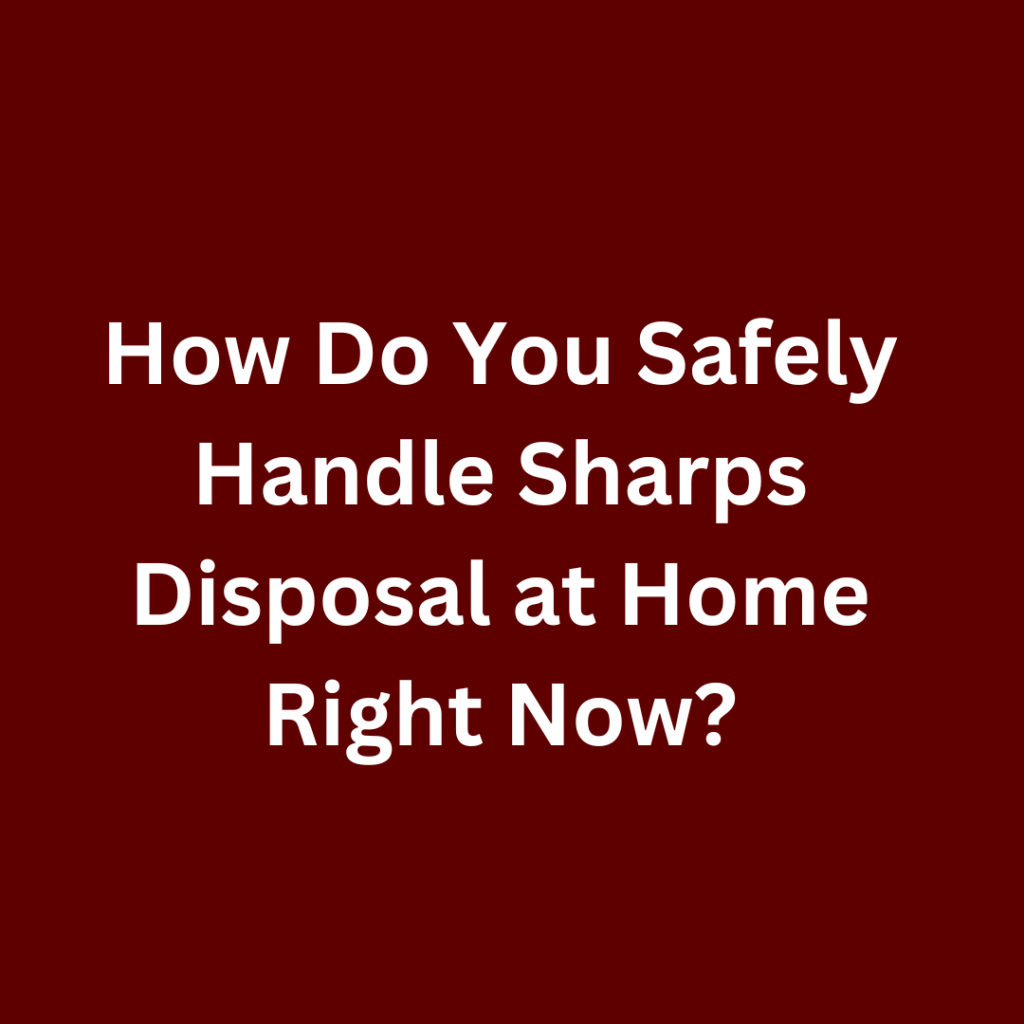Household biohazard waste includes sharps such as needles and lancets, along with blood-contaminated bandages, gloves, and items containing bodily fluids from personal care or minor injuries. While federal regulations delegate authority to states, essential principles emphasize puncture-resistant containers for sharps, double-bagging for soft materials, and utilizing pharmacy or hospital drop-off services to prevent injuries and disease transmission, including hepatitis. Improper management creates risks of needle stick injuries to family members or waste management workers, potential fines reaching $25,000, and environmental contamination.

Essential steps include using FDA-approved containers, securing them properly, and finding local disposal sites through SafeNeedleDisposal.org. A crucial lesson from real-world incidents: A single unsecured needle in household trash can injure sanitation personnel, leading to guilt and legal complications. Handle responsibly to safeguard everyone.
Understanding Biohazard Waste in Your Household
Have you ever questioned whether that used bandage from your recent cut requires special handling? Biohazard waste encompasses any material contaminated with blood, bodily fluids, or infectious substances capable of transmitting pathogens. In residential settings, consider common items from diabetes management, medication administration, or wound care.
Sharps represent the primary concern: needles, syringes, lancets from glucose monitoring, or bloodied razor fragments. Secondary materials include contaminated gloves, gauze, or swabs saturated with blood or discharge. Laboratory cultures from home experiments qualify if applicable, though most households deal with medical self-care waste. The EPA broadly defines this as waste containing potentially infectious agents, but residential volumes remain minimal compared to healthcare facilities.
However, not all items qualify. Clean bandages without visible blood contamination or single-use masks without fluid exposure typically belong in regular waste. Verify your state’s regulations, as jurisdictions like California impose stricter classifications. The principle: if it could puncture or leak infectious material, treat it as biohazardous.
The Critical Importance of Proper Biohazard Waste Disposal

You might consider discarding a needle in regular trash insignificant, but the consequences are substantial. Improper disposal facilitates disease transmission including HIV and hepatitis through accidental exposure. Sanitation workers experience 385,000 sharps injuries annually nationwide, many originating from residential waste. Children or pets exploring trash could suffer injuries, transforming your home into a danger zone.
Environmental impacts include pollution: fluids seep into landfills, contaminating groundwater. Financial penalties are severe; states like New York impose fines up to $25,000 for violations. Moreover, it’s about community responsibility. Proper management protects neighborhoods and prevents the devastating guilt of causing illness through negligence.
Mike’s Story: The Hidden Needle Incident – An Expensive Lesson in Carelessness
Consider Mike, a father in his forties managing a recent diabetes diagnosis while balancing family responsibilities. Enthusiastic about home health management, he began daily blood sugar testing. Lancets accumulated rapidly, but amid school schedules and work demands, Mike compromised safety. “It’s merely a tiny puncture,” he reasoned, wrapping used lancets in tissue and disposing of them in kitchen waste. No specialized container, no protective packaging. Simple, right?
Several weeks later, catastrophe occurred. His wife, Lisa, collected a garbage bag for curbside pickup and felt a sharp penetration through her glove. Blood appeared from her thumb. Panic ensued as they rushed to the emergency room for testing. Fortunately, Mike’s lancet carried no active pathogens, but the waiting period devastated them: four anxious weeks of uncertainty, prophylactic antibiotics, and follow-up appointments costing $1,200 out-of-pocket. Lisa’s hand became inflamed, work performance suffered, and marital trust deteriorated. “How could something so small create this chaos?” she questioned.
The realization struck Mike profoundly. Guilt overwhelmed him; he mentally replayed every careless disposal, understanding how one mistake endangered his family. A health department consultation revealed local regulations prohibiting loose sharps in household waste, with potential fines if violations were reported. More devastating was the emotional damage: arguments about responsibility, fear of “what if infection had occurred?”
The lesson transformed Mike immediately. He purchased a sharps container that day, labeled it appropriately, and located drop-off locations at nearby pharmacies. He shared his experience at support groups, converting regret into education. Now, his household operates safely, waste handled correctly, and Lisa’s scar serves as a reminder. Mike’s insight resonates: minor precautions prevent major heartbreak. Dispose properly, consistently, and thoughtfully.
Safe Sharps Disposal Procedures for Immediate Implementation
Sharps require immediate attention to prevent punctures. Begin with an FDA-approved sharps container: puncture-resistant plastic construction, secure closure, typically red or labeled “sharps.” No commercial option available? Repurpose a sturdy detergent bottle: empty completely, create a small opening in the cap for needle insertion, seal with tape when full.
Never recap needles; this causes 20% of injuries. Insert used sharps directly, point-first. Maintain upright positioning, away from children and pets, perhaps on elevated storage. Avoid overfilling: stop at three-quarters capacity to prevent spillage. Seal with strong tape, label “sharps, do not recycle,” and store until disposal.
The CDC emphasizes: activate safety features on syringes first, then dispose. When traveling, carry portable containers. These simple practices reduce risks by 80%.
Disposing of Biohazard Materials Including Bandages and Gloves

Soft waste avoids sharp puncture risks but requires careful handling. Double-bag blood-contaminated items in plastic grocery bags or specialized biohazard red bags when available. Twist and secure tightly to prevent leakage. For minimal quantities, states like Texas permit household waste disposal after bleach disinfection.
Larger volumes require leak-proof containers. Dispose of gloves after each use, never loose. The key principle: contain fluids to prevent odors and spills. For pathological materials like post-surgical tissues, treat as infectious and arrange professional pickup. Always wear protective gloves during handling for personal safety.
Locating Final Disposal Sites for Full Biohazard Containers
Don’t allow full containers to accumulate. Most states provide free drop-off services: pharmacies like Walgreens, hospitals, or fire departments. Search SafeNeedleDisposal.org for nearby locations; it maps over 10,000 sites.
Mail-back programs serve remote areas effectively: prepaid containers from vendors like Sharps Compliance, starting at $20 for four units. Follow USPS regulations: no loose items, declare at post office. Some communities host quarterly collection events.
Household waste disposal? Only where state-permitted, like New York for contained sharps. Always verify: California maintains stricter prohibitions. Professional services like Stericycle offer monthly pickup for $50 if you generate substantial volumes. Convenience outweighs risk consistently.
How Local Regulations Impact Biohazard Disposal Strategies
Regulations vary significantly by state, making location crucial for compliance. California strictly regulates all medical waste: generators exceeding certain volumes require manifests and licensed haulers. Texas maintains simplicity for households: waste acceptable if properly contained.
New York mandates hospital drop-offs for sharps, legally required to be free. Florida uses mixed approaches: sharps in waste if puncture-proof, but infectious materials need specialized bags. The EPA delegates to states, so contact your environmental department or use HERCenter’s state locator.
Urban versus rural locations matter: cities offer more sites, but verify through apps for updates. In 2025, fifteen states strengthened post-pandemic regulations, adding mail-back requirements. Know your local rules to avoid penalties and maintain compliance.
Essential Protective Equipment for Biohazard Waste Handling
Managing waste requires appropriate protection. Begin with nitrile gloves: thicker than latex, puncture-resistant. Disposable gowns or aprons protect clothing from contamination. Eye protection like safety goggles guards against airborne droplets.
Masks? N95 for airborne hazards, though surgical masks suffice for most home applications. Maintain a bathroom kit: gloves, disinfectant wipes, biohazard bags. Wash hands thoroughly for 20 seconds after handling, even when wearing gloves. OSHA mandates this for bloodborne pathogen prevention; neglect invites infection.
Pre-Disposal Disinfection of Biohazard Waste
Disinfection reduces risks but isn’t comprehensive protection. For soft materials, immerse in 1:10 bleach solution for 10 minutes, rinse, and bag. Alcohol wipes work for surfaces but don’t penetrate deeply.
Sharps require different handling: avoid soaking as it dulls edges and spreads contamination. Autoclaving is professional-grade, unsuitable for home use. EPA notes household volumes rarely require intensive treatment, but for heavy contamination, contact professional services. Always follow with proper containment.
Common Home Biohazard Disposal Mistakes
Frequent errors create household hazards. The primary mistake: loose sharps in regular trash, causing 30% of worker injuries. Another: overfilling containers, resulting in spillage. Mixing waste types? Sharps puncture soft waste bags.
Inadequate labeling invites mishandling. Ignoring local regulations incurs fines. Multitasking during disposal leads to liquid spills. DIY approaches beyond basics: excessive bleach doesn’t eliminate embedded pathogens. Learn from these errors to maintain safety.
Pet Biohazard Waste Integration into Home Disposal
Pet waste overlaps when blood-contaminated, such as from injuries or veterinary care. Needles from pet medications count as sharps, following identical rules. Feces containing blood requires double-bagging as soft waste.
Vaccination tags or laboratory cultures should be treated as infectious. Most materials can be disposed of in household waste if properly contained, but verify state regulations: Colorado prohibits certain animal wastes in landfills. Maintain separate pet areas to prevent cross-contamination.
Mail-Back Programs for Convenient Disposal Solutions
Mail-back systems simplify disposal for regular generators. Kits include containers, return labels, and instructions. Fill, seal, and ship via USPS or UPS. Costs range $15-50 per kit, but peace of mind is invaluable.
Sharps Compliance leads with 2025 improvements: prepaid postage and tracking capabilities. EPA endorses programs for households lacking drop-off access. Monitor shipments online; materials arrive at treatment facilities for incineration. Perfect for rural locations or frequent users.
Environmentally Conscious Biohazard Waste Reduction
Prevention surpasses disposal. Reuse containers safely, like multi-dose vials with proper hygiene. Switch to auto-injectors minimizing sharp waste. Recycle uncontaminated packaging.
Composting isn’t suitable for biohazards. Choose biodegradable gloves when uncontaminated. 2025 trends promote sustainable kits: recyclable plastics post-treatment. Small changes reduce volume, easing disposal burden.
Teaching Children Safe Biohazard Handling Practices
Children need fundamental knowledge without causing fear. Explain sharps as “dangerous sticks” requiring immediate placement in special containers. Demonstrate using empty syringes: insert and seal.
Establish routines: family waste days include container inspections. Utilize CDC kid-friendly resources: educational videos about germ transmission. Reward safe behaviors. As children mature, introduce glove usage. This builds lifelong safety awareness.
Response to Suspected Waste-Related Injuries
Act immediately: notify injured parties, offer medical assistance. Report to health departments if disease risk exists. Document thoroughly: photographs, timelines. Consult legal counsel if claims develop; insurance may provide coverage.
Learn from incidents: audit your procedures. Most accidents result from skipped fundamentals. Transform experiences into prevention, like Mike’s transformation.
Frequently Asked Questions
Q: Can I dispose of small biohazard waste amounts in regular trash? A: State-dependent; many permit contained and disinfected waste, but never loose sharps. Check SafeNeedleDisposal.org.
Q: What’s the optimal home sharps container? A: FDA-cleared plastic units, or heavy-duty bottles like detergent containers with secured lids.
Q: How frequently should sharps containers be emptied? A: When three-quarters full, or monthly for safety.
Q: Do mail-back programs accept all biohazard types? A: Primarily sharps and soft materials; confirm with providers for pathological waste.
Q: Are free disposal options available locally? A: Yes, hospitals and pharmacies often provide services; search state environmental websites.
Q: What if local regulations are unclear? A: Contact your state’s EPA equivalent or use HERCenter locator for guidance.
Need Immediate Biohazard Waste Removal and Cleanup in Columbus?
Call PuroClean Home Savers now at (614) 689-0012 for fast, safe, and reliable service.
With over 15 years of experience in biohazard waste removal, cleanup, and property restoration, our certified team has helped countless Columbus homeowners and businesses safely manage hazardous materials like sharps, blood-soaked items, and infectious waste.
We’re proud to have earned 100+ five-star reviews on Google, reflecting our commitment to quality, safety, and customer satisfaction.
Read our verified customer reviews and see why Columbus trusts PuroClean Home Savers for professional biohazard cleanup and restoration.
Conclusion
Proper home biohazard waste disposal isn’t complex; it requires containment, prompt action, and local regulation knowledge. From Mike’s awakening to your daily precautions, the message is clear: protect others while protecting yourself. Acquire appropriate containers, locate disposal sites, and maintain peace of mind. Your next step: verify local regulations today.


